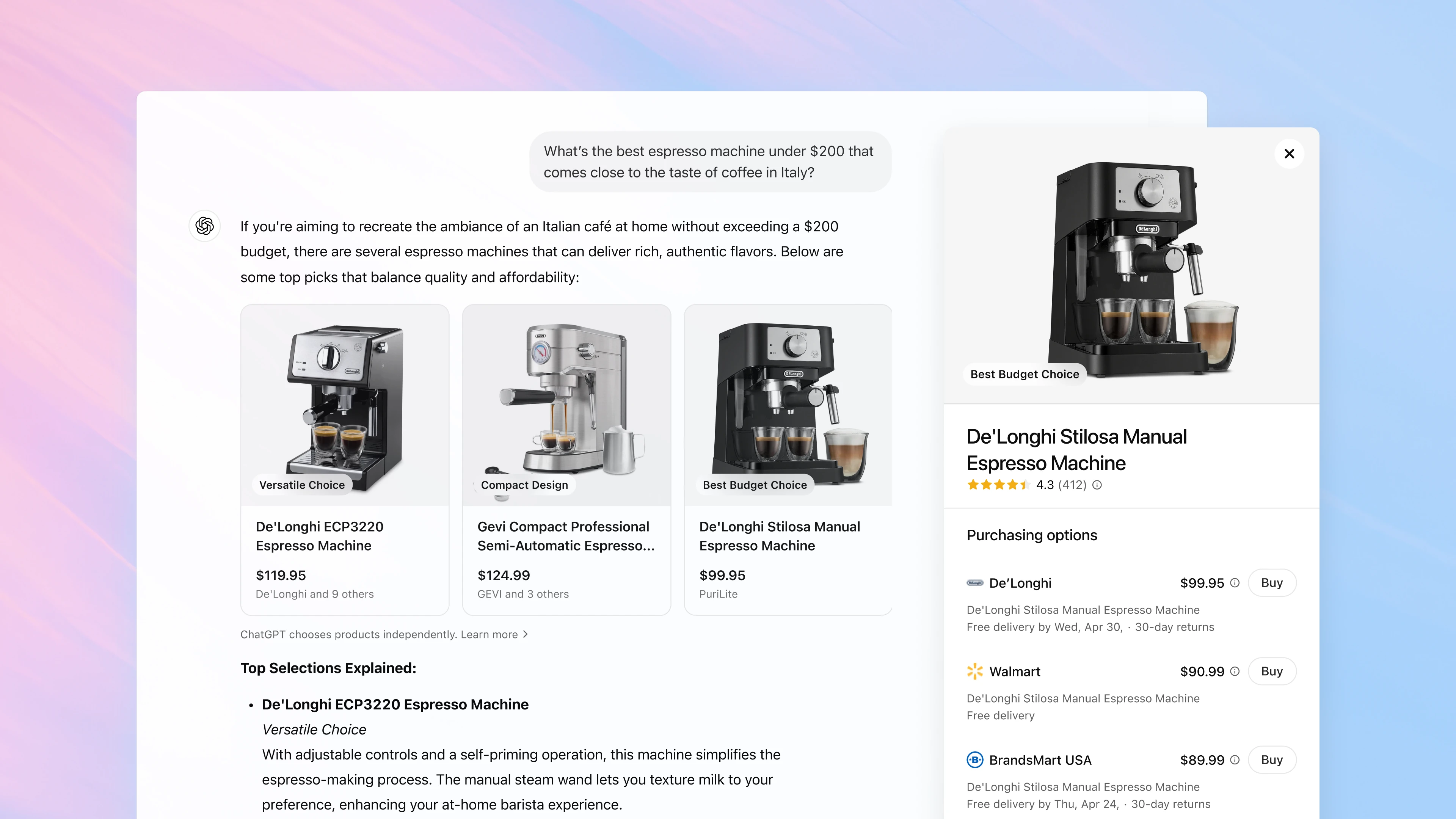
 Neri Bluman
Neri BlumanIntroduction
OpenAI has rolled out a major update to ChatGPT, integrating real-time shopping results directly into the chat experience and experimenting with making product discovery simpler, faster, and smarter.
This isn't just a UI update. It's a strategic shift that could redefine how consumers find and buy products online - bypassing traditional search engines entirely.
Now, users can type natural-language queries like: "What are the best travel backpacks under 100 euros?" …and get curated product recommendations complete with prices, images, brand names, and direct links to online stores. All without ever opening a browser tab.
For brands, this means visibility inside AI results is becoming just as critical as ranking on Google. If your products aren't appearing in these AI-generated answers, you're not just losing traffic - you're missing out on the entire customer conversation.
In this guide, we'll break down what ChatGPT Shopping is, how it works, what's changed with the recent rollout, and how your brand can start showing up inside AI-powered product discovery.
What Is ChatGPT Shopping?
ChatGPT Shopping is an AI-powered product discovery experience built directly into ChatGPT - currently available for ChatGPT Plus users with browsing enabled. Instead of browsing endless category pages or typing short keywords into Google, users can now ask for product suggestions using natural language.

For example, someone might ask: "Can you recommend high-quality hair dryers under $100?"
ChatGPT then generates a response by pulling from a mix of sources - including editorial reviews, brand websites, product listings, UGC, and affiliate sites. Responses typically include product names, prices, store links, and short descriptions.
It makes shopping feel more intuitive and conversational, as users get curated, real-time product suggestions based on natural queries - a key part of ChatGPT's improved shopping experience.
This turns ChatGPT into a powerful product discovery layer. And if your store isn't being mentioned or cited in these responses, you're missing out on crucial visibility at the moment of purchase intent.
Why eCommerce Brands Should Care
There are three key reasons ChatGPT Shopping matters for your business:
It bypasses traditional SEO
Users don't go to a search results page - they get answers directly inside ChatGPT. If your products aren't listed there, you're invisible.
It recommends, not just ranks
ChatGPT doesn't display links; it suggests products like a trusted advisor. This changes how your brand builds authority and trust.
It's expanding fast
With OpenAI, Bing, and others investing in AI shopping tools, this model is quickly becoming the new discovery standard.
If AI assistants become the default shopping gateway, being absent from their "answers" will cost brands traffic and sales.
How to Get Your Store Listed in ChatGPT Shopping
Right now, there's no "upload your catalog" feature or direct feed submission for ChatGPT Shopping. Instead, ChatGPT surfaces product suggestions by pulling from content already available on the web.
To increase the chances of your products being featured, focus on these tactics:
Get Mentioned by Trusted Sources
ChatGPT often references well-known review sites and communities like Wirecutter, TechRadar, Wikipedia, Reddit, and Quora.
Being cited in trusted third-party content signals credibility to the AI. Consider affiliate partnerships, PR outreach, or pitching to niche bloggers in your industry.
Optimize Product Pages with Rich, Useful Content
Your product pages shouldn't just list specs - they should tell a story. Include comparisons, real-world use cases, unique selling points, and descriptive language that mimics how users actually talk about your product.
Create Structured, Answer-Friendly Content
AI systems are more likely to reference content that's easy to parse and informative. Formats that work well include:
- Listicles (e.g., "Top 7 Eco-Friendly Toothbrushes in 2024")
- FAQs ("What's the best ergonomic office chair under $200?")
- In-depth buying guides with direct product suggestions
Use Semantic, Natural-Language Keywords
Focus on how users ask questions, not just short-tail keywords. For example:
Instead of: "Running Shoes"
Try: "What are the best running shoes for flat feet in summer?"
This mirrors how users interact with ChatGPT - and how AI understands product context.
Ensure Your Content Is Crawlable
AI systems rely on accessible, high-quality HTML content. Make sure your key product and blog pages aren't hidden behind login walls or built entirely with JavaScript frameworks that block crawling.
Use clean HTML, include structured data (like Schema.org markup), and make sure key pages are indexable.
This approach gives your products a higher chance of being surfaced when ChatGPT generates shopping suggestions.
Visibility Challenges in AI Shopping Results
Even if your products are well-optimized, they may not show up in ChatGPT Shopping results. Common challenges include:
- Lack of Mentions in Authoritative Content
- Limited Online Presence Outside Your Own Site
- Unstructured Product Data
- No Tracking of AI Visibility (most SEO tools don't show if you appear in ChatGPT)
That's where platforms like XFunnel step in.
Using XFunnel to Track and Improve AI Visibility
XFunnel is built to monitor and improve how visible your brand or store is in AI-generated search results - including ChatGPT Shopping.

The ChatGPT shopping experience provides users with curated product recommendations, making brand visibility in AI results crucial for eCommerce success
Here's what it can do:
- See Which Questions Mention Your Brand: Know exactly when and where your products are being recommended by AI.
- Find Product Discovery Gaps: Learn which product types or questions you're not showing up for (but competitors are).
- Get Smart Optimization Tips: Get AI-driven suggestions for improving your product content, including what third-party mentions to target.
- Track AI Citation Sources: Find out what AI search engines look for in citations within your niche - so you can focus your outreach accordingly.
Think of it as an AI visibility dashboard specifically for eCommerce in the age of conversational shopping.
Conclusion & Next Steps
We're entering a new era of product discovery - one where AI assistants are the starting point, and content visibility means being mentioned in answers, not just ranked in results.
If you're an eCommerce brand, now is the time to:
- Audit your product content for AI friendliness
- Get your store or brand cited in trusted third-party sources
- Use tools like XFunnel to measure and improve your AI visibility
ChatGPT Shopping isn't a future trend - it's already here. And the brands that understand how it works will be the ones shoppers see first.

About the Author
A seasoned entrepreneur who co-founded and led a startup in the U.S. for nearly seven years. With deep expertise in AI and go-to-market strategy, Neri has invested in and consulted with numerous ventures, bringing invaluable insights into how generative AI and LLMs are reshaping the future of business discovery.
As the co-founder of XFunnel, Neri is pioneering new approaches to help businesses understand and optimize their presence across AI-powered platforms, ensuring brands are accurately represented in the rapidly evolving landscape of AI search.
Related Posts
- llms.txt: The New Frontier of AI Crawling and SEO – An introduction to the proposed llms.txt standard for making your website more accessible to AI crawlers.
- AI Search Engine Optimization in 2025 - Discover the latest AI search engine optimization strategies that are driving results in 2025, from citations to content structure.